Analysis on Response of a Single Pile Subjected to Tension Load Considering Excavation Effects
Abstract
:1. Introduction
2. Pile Response after Excavation
3. Load-Transfer Model Considering Excavation Effects
3.1. Load Transfer Relationship of a Single Pile
3.2. Nonlinear Shear Displacement of the Soil Outside the Pile–Soil Interface
3.3. Greenfield Soil Heave Displacement
3.4. Load Transfer Relationship of Pile–Soil Interaction
4. Difference Numerical Method to Solve the Load Transfer Model
4.1. Difference Scheme of Load-Transfer Method
4.2. Iterative Algorithm for the Proposed Difference Scheme
- (1)
- Calculate the greenfield soil heave using Equation (9). Assume that the initial pile displacement and shear-induced soil displacement at each node are equal to zero.
- (2)
- Calculate the pile–soil relative displacement and pile shaft resistance of each node using Equations (1) and (11). As a consequence, the parameter of each node could be determined.
- (3)
- Calculate the node stiffness matrix and node force vector . Update the pile displacement of each node by solving Equation (23).
- (4)
- Update the pile–soil relative displacement, the pile shaft resistance, and the shear-induced soil displacement of each node using the new pile node displacement. Then, update the parameter of each node.
- (5)
- Update the node stiffness matrix and node force vector . The new pile displacement at each node can thus be obtained.
- (6)
- Repeatedly execute steps 4 and 5 until convergence is achieved.
- (7)
- Obtain the pile–soil relative displacement after excavation. Calculate the residual pile–soil relative displacement at each node. Assume that the initial pile displacement at each node is equal to the pile head settlement , and shear-induced soil displacement at each node is equal to zero.
- (8)
- Calculate the pile–soil relative displacement and pile shaft resistance of each node using Equations (2) and (18). Consequently, the parameters of each node could be determined.
- (9)
- Calculate the node stiffness matrix and node force vector . Update the pile displacement of each node by solving Equation (29).
- (10)
- Update the pile–soil relative displacement, the pile shaft resistance, and the shear-induced soil displacement of each node using the new pile node displacement. Then, update the parameters of each node.
- (11)
- Update the node stiffness matrix and node force vector . The new pile displacement at each node can thus be obtained.
- (12)
- Repeatedly execute steps 10 and 11 until convergence is achieved.
5. Validation of the Proposed Approach
5.1. Case One
5.2. Case Two
5.3. Case Three
5.4. Case Four
6. Discussion
6.1. Effects of Soil Friction Angle on Change in Pile Capacity after Excavation
6.2. Effects of Soil Shear Modulus on Change in Pile Capacity after Excavation
6.3. Effects of Soil Poisson’s Ratio on Change in Pile Capacity after Excavation
7. Conclusions
- (1)
- The comparisons between the results from the proposed methods, well-documented field tests, centrifuge tests, and other analytical methods showed that the proposed approach was suitable for analyzing an uplift pile considering excavation effects.
- (2)
- The soil friction angle has a great influence on the pile uplift capacity loss caused by the excavation. The pile capacity loss decreases linearly with increasing soil effective friction angle. When the effective pile length is equal to excavation depth, the pile capacity loss decreases from 52.5% to 38.9%, with the soil effective angle increasing from 20° to 35°.
- (3)
- The pile uplift capacity loss caused by the excavation is not affected by the soil shear modulus or Poisson’s ratio.
- (4)
- The pile uplift capacity loss caused by the excavation is related to the ratio of the excavation depth to the effective pile length. The pile capacity loss increases with the ratio of the excavation depth to the effective pile length decreases.
Author Contributions
Funding
Institutional Review Board Statement
Informed Consent Statement
Data Availability Statement
Conflicts of Interest
Appendix A
References
- Xu, J.; Franza, A.; Marshall, A.M.; Losacco, N. Role of Footing Embedment on Tunnel-Foundation Interaction. J. Geotech. Geoenviron. Eng. 2021, 147, 06021009. [Google Scholar] [CrossRef]
- Cheng, K.; Xu, R.; Ying, H.; Gan, X.; Zhang, L.; Liu, S. Observed performance of a 30.2 m deep-large basement excavation in Hangzhou soft clay. Tunn. Undergr. Space Technol. 2021, 111, 103872. [Google Scholar] [CrossRef]
- Zadehmohamad, M.; Bazaz, J.B.; Riahipour, R.; Farhangi, V. Physical modeling of the long-term behavior of integral abutment bridge backfill reinforced with tire-rubber. Int. J. Geo-Eng. 2021, 12, 1–19. [Google Scholar] [CrossRef]
- Sun, Y.; Shen, S.; Xu, Z.; Xia, X. Prediction of lateral displacement of soil behind the reaction wall caused by pipe jacking operation. Tunn. Undergr. Space Technol. 2014, 40, 210–217. [Google Scholar] [CrossRef]
- Wrzesiński, G.; Lechowicz, Z. Testing of undrained shear strength in a hollow cylinder apparatus. Studia Geotech. Mech. 2015, 37, 69–73. [Google Scholar] [CrossRef] [Green Version]
- Wrzesiński, G. Anisotropy of soil shear strength parameters caused by the principal stress rotation. Arch. Civ. Eng. 2021, 67, 163–187. [Google Scholar]
- Wrzesiński, G.; Markiewicz, A. Prediction of Permeability Coefficient k in Sandy Soils Using ANN. Sustainability 2022, 14, 6736. [Google Scholar] [CrossRef]
- Taishan, L.; Songyu, L.; Guojun, C.; Kai, W.; Zan, L. Effect of Excavation Disturbance on Clayey Soil Mechanical Properties and Pile Capacity. Int. J. Geomech. 2022, 22, 5022003. [Google Scholar] [CrossRef]
- Feng, R.F.; Zhang, Q.Q.; Liu, S.W. Experimental study of the effect of excavation on existing loaded piles. J. Geotech. Geoenviron. Eng. 2020, 146, 04020091. [Google Scholar] [CrossRef]
- Zheng, G.; Peng, S.Y.; Ng, C.; Diao, Y. Excavation effects on pile behaviour and capacity. Can. Geotech. J. 2012, 49, 1347–1356. [Google Scholar] [CrossRef]
- Karimipour, A.; Farhangi, V. Effect of EBR- and EBROG-GFRP laminate on the structural performance of corroded reinforced concrete columns subjected to a hysteresis load. Structures 2021, 34, 1525–1544. [Google Scholar] [CrossRef]
- Zhang, Q.; Liu, S.; Feng, R.; Li, X. Analytical method for prediction of progressive deformation mechanism of existing piles due to excavation beneath a pile-supported building. Int. J. Civ. Eng. 2019, 17, 751–763. [Google Scholar] [CrossRef]
- Troughton-Ove, V.M. The effects of changes in effective stress on a base grouted pile in sand. In Piling and Deep Foundations, Proceedings of the International Conference on Piling and Deep Foundations, London, UK, 15–18 May 1989; CRC Press: Boca Raton, FL, USA; p. 445.
- Zheng, G.; Diao, Y.; Ng, C. Parametric analysis of the effects of stress relief on the performance and capacity of piles in nondilative soils. Can. Geotech. J. 2011, 48, 1354–1363. [Google Scholar] [CrossRef]
- Li, J.J.; Huang, M.S.; WANG, W.; Chen, Z. Centrifugal model tests on bearing capacity of uplift piles under deep excavation. Chin. J. Geotech. Eng. 2010, 32, 388–396. [Google Scholar]
- Lee, C.J.; Al-Tabbaa, A.; Bolton, M.D. Development of tensile force in piles in swelling ground. In Soft Soil Engineering; Lee, C.F., Lau, C.K., Ng, C.W., Kwong, A.K., Pang, P.L., Yin, J.H., Yue, Z.Q., Eds.; Routledge: Oxfordshire, UK, 2001; pp. 345–350. ISBN 90-265-1866-8. [Google Scholar]
- Zhang, Q.Q.; Li, S.C.; Liang, F.Y.; Yang, M.; Zhang, Q. Simplified method for settlement prediction of single pile and pile group using a hyperbolic model. Int. J. Civ. Eng. 2014, 12, 146–159. [Google Scholar]
- Wang, Z.; Xie, X.; Wang, J. A new nonlinear method for vertical settlement prediction of a single pile and pile groups in layered soils. Comput. Geotech. 2012, 45, 118–126. [Google Scholar] [CrossRef]
- Baziar, M.H.; Saeedi Azizkandi, A.; Kashkooli, A. Prediction of pile settlement based on cone penetration test results: An ANN approach. KSCE J. Civ. Eng. 2015, 19, 98–106. [Google Scholar] [CrossRef]
- Chung, S.-H.; Yang, S.-R. Numerical analysis of small-scale model pile in unsaturated clayey soil. Int. J. Civ. Eng. 2017, 15, 877–886. [Google Scholar] [CrossRef]
- Liu, S.W.; Zhang, Q.Q.; Cui, C.Y.; Feng, R.F.; Cui, W. A simplified approach for the response of pile groups composed of dissimilar piles. In Structures; Elsevier: Amsterdam, The Netherlands, 2021; Volume 34. [Google Scholar]
- Lashkari, A. A simple critical state interface model and its application in prediction of shaft resistance of non-displacement piles in sand. Comput. Geotech. 2017, 88, 95–110. [Google Scholar] [CrossRef]
- Zhang, Q.; Zhang, Z.-M.; He, J.-Y. A simplified approach for settlement analysis of single pile and pile groups considering interaction between identical piles in multilayered soils. Comput. Geotech. 2010, 37, 969–976. [Google Scholar] [CrossRef]
- Li, L.; Li, J.; Sun, D.; Gong, W. Semi-analytical approach for time-dependent load-settlement response of a jacked pile in clay strata. Can. Geotech. J. 2017, 54, 1682–1692. [Google Scholar] [CrossRef] [Green Version]
- Li, L.; Dong, L.; Lu, C.; Wu, W.; Wen, M.; Liang, R. Analysis of Bearing Characteristics of Energy Pile Group Based on Exponential Model. Energies 2021, 14, 6881. [Google Scholar] [CrossRef]
- Zhang, Q.; Zhang, Z.-M. A simplified nonlinear approach for single pile settlement analysis. Can. Geotech. J. 2012, 49, 1256–1266. [Google Scholar] [CrossRef]
- Kim, S.; Jeong, S.; Cho, S.; Park, I. Shear load transfer characteristics of drilled shafts in weathered rocks. J. Geotech. Geoenviron. Eng. 1999, 125, 999–1010. [Google Scholar] [CrossRef]
- Randolph, M.F.; Wroth, C.P. An analysis of the vertical deformation of pile groups. Geotechnique 1979, 29, 423–439. [Google Scholar] [CrossRef]
- Zhang, Q.; Zhang, Z.-M. Simplified calculation approach for settlement of single pile and pile groups. J. Comput. Civ. Eng. 2012, 26, 750–758. [Google Scholar] [CrossRef]
- Zhang, Q.-Q.; Li, S.-C.; Zhang, Q.; Li, L.-P.; Zhang, B. Analysis on Response of a Single Pile Subjected to Tension Load Using a Softening Model and a Hyperbolic Model. Mar. Georesour. Geotechnol. 2015, 33, 167–176. [Google Scholar] [CrossRef]
- Kulhawy, F.H.; Mayne, P.W. Manual on Estimating Soil Properties for Foundation Design; Technical report No. EPRI-EL-6800; Electric Power Research Institute: Palo Alto, CA, USA, 1990. [Google Scholar]
- Miller, G.A.; Lutenegger, A.J. Influence of pile plugging on skin friction in overconsolidated clay. J. Geotech. Geoenviron. Eng. 1997, 123, 525–533. [Google Scholar] [CrossRef]
- Sowa, V.A. Pulling capacity of concrete cast in situ bored piles. Can. Geotech. J. 1970, 61, 482–493. [Google Scholar] [CrossRef]
- Goel, S.; Patra, N.R. Prediction of load displacement response of single piles under uplift load. Geotech. Geol. Eng. 2007, 25, 57–64. [Google Scholar] [CrossRef]
- Guerra, L. Physical Modeling of Bored Piles in Sand. Ph.D. Thesis, Ferrara University, Ferara, Italy, 2010. [Google Scholar]
- Loukidis, D.; Salgado, R. Analysis of the shaft resistance of non-displacement piles in sand. Geotechnique 2008, 58, 283–296. [Google Scholar] [CrossRef] [Green Version]
- Cui, C.Y.; Wang, S.J.; Liu, Q.; Zhang, Y.L. An approach for response prediction of a single pile subjected to tension load considering modulus degradation of soil. Geotech. Geol. Eng. 2020, 38, 1195–1203. [Google Scholar] [CrossRef]
- Hu, Q.; Ling, D.S.; Kong, L.G.; Luo, Y.W.; Niu, M.; Chen, Z. Effects of deep excavation on uplift capacity of piles by centrifuge tests. Chin. J. Geotech. Eng. 2013, 35, 1076–1083. [Google Scholar]
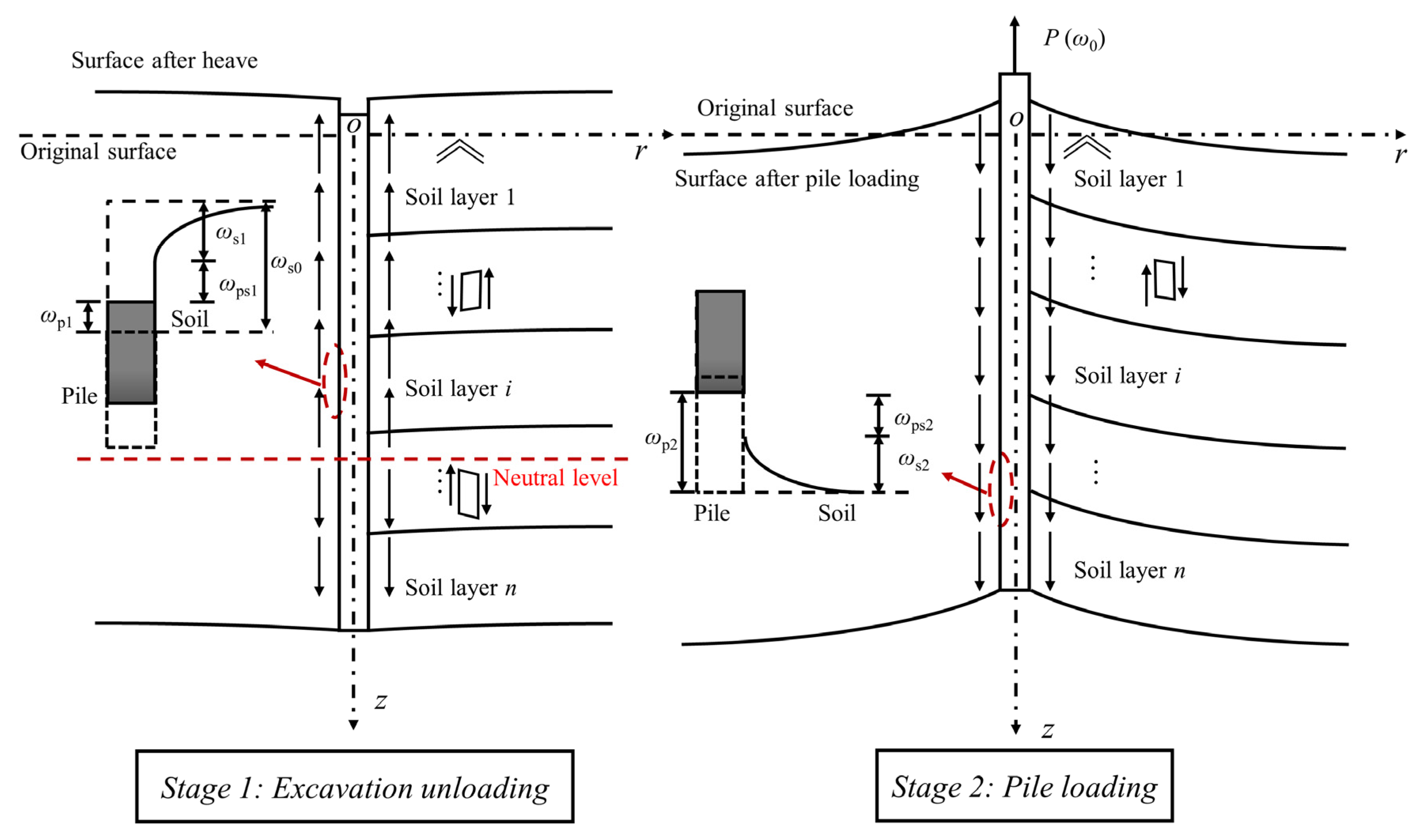
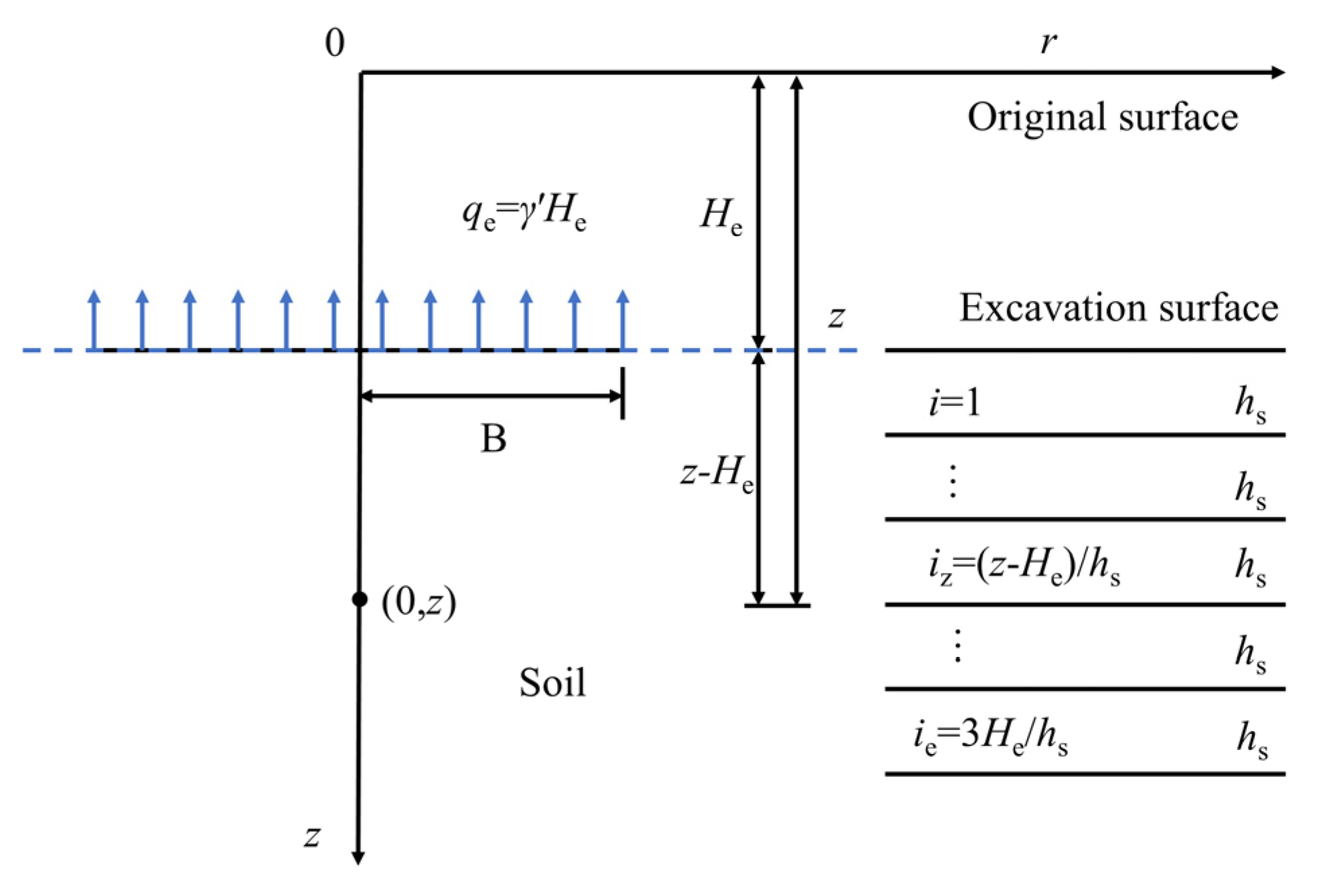

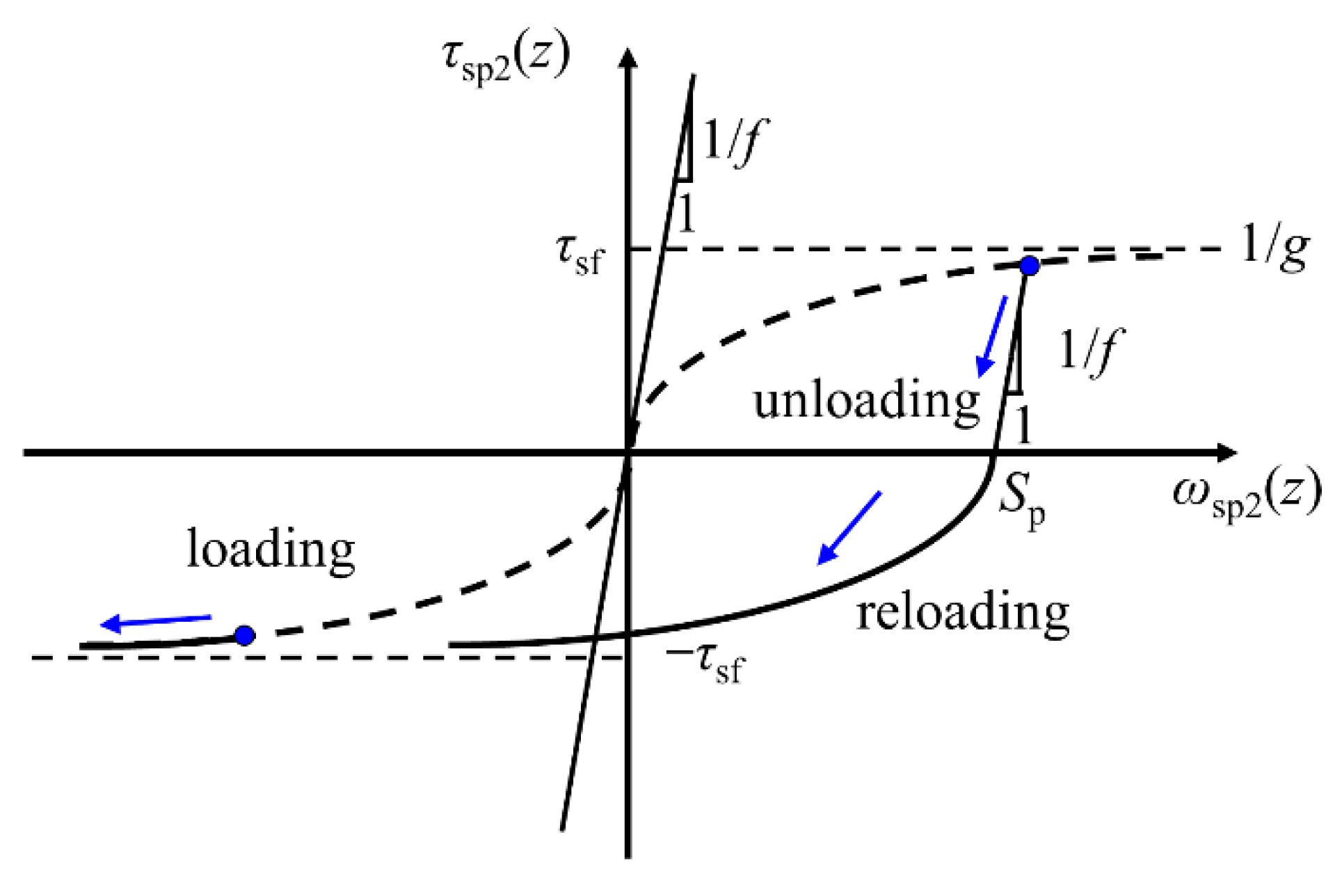

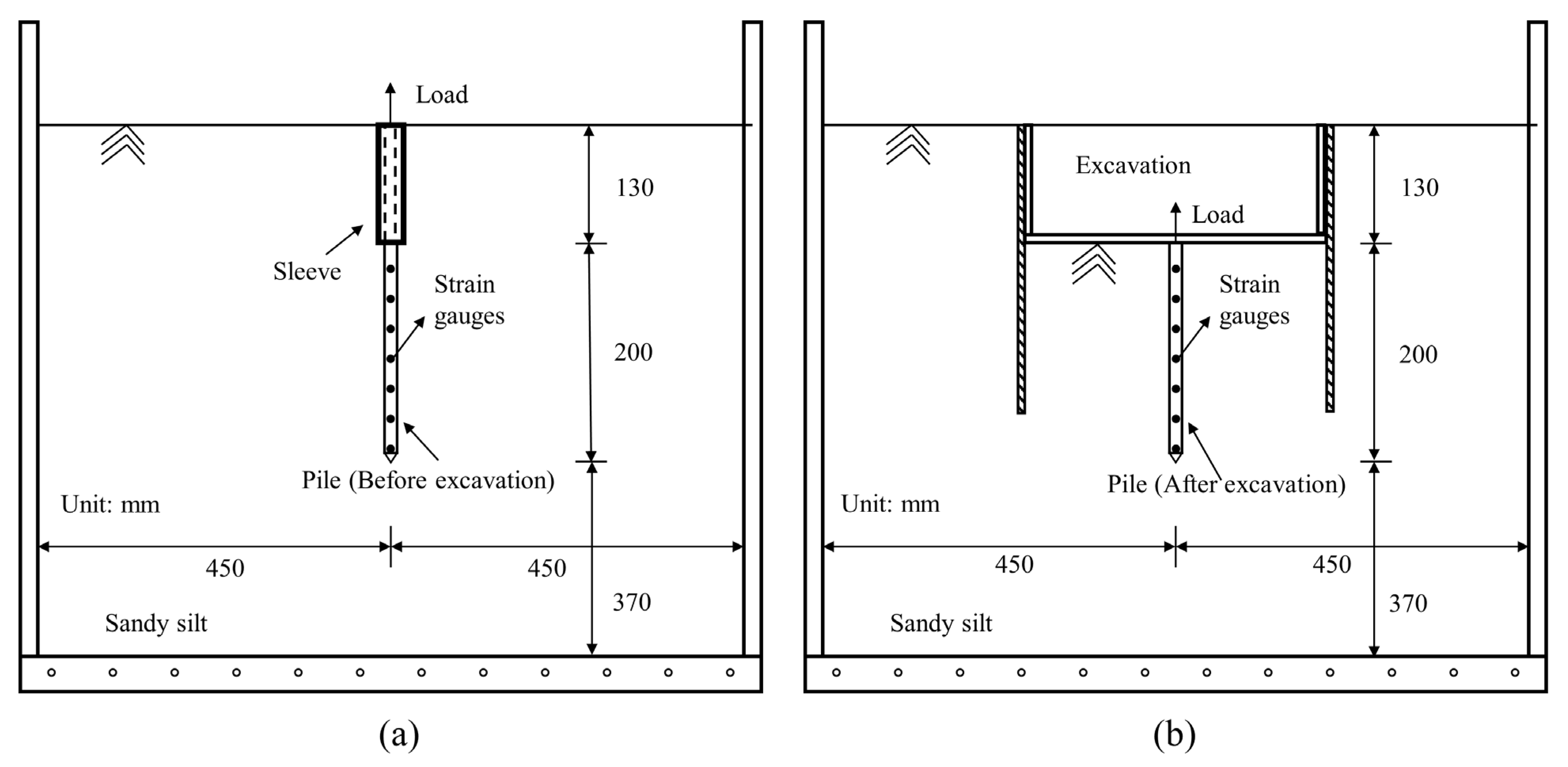
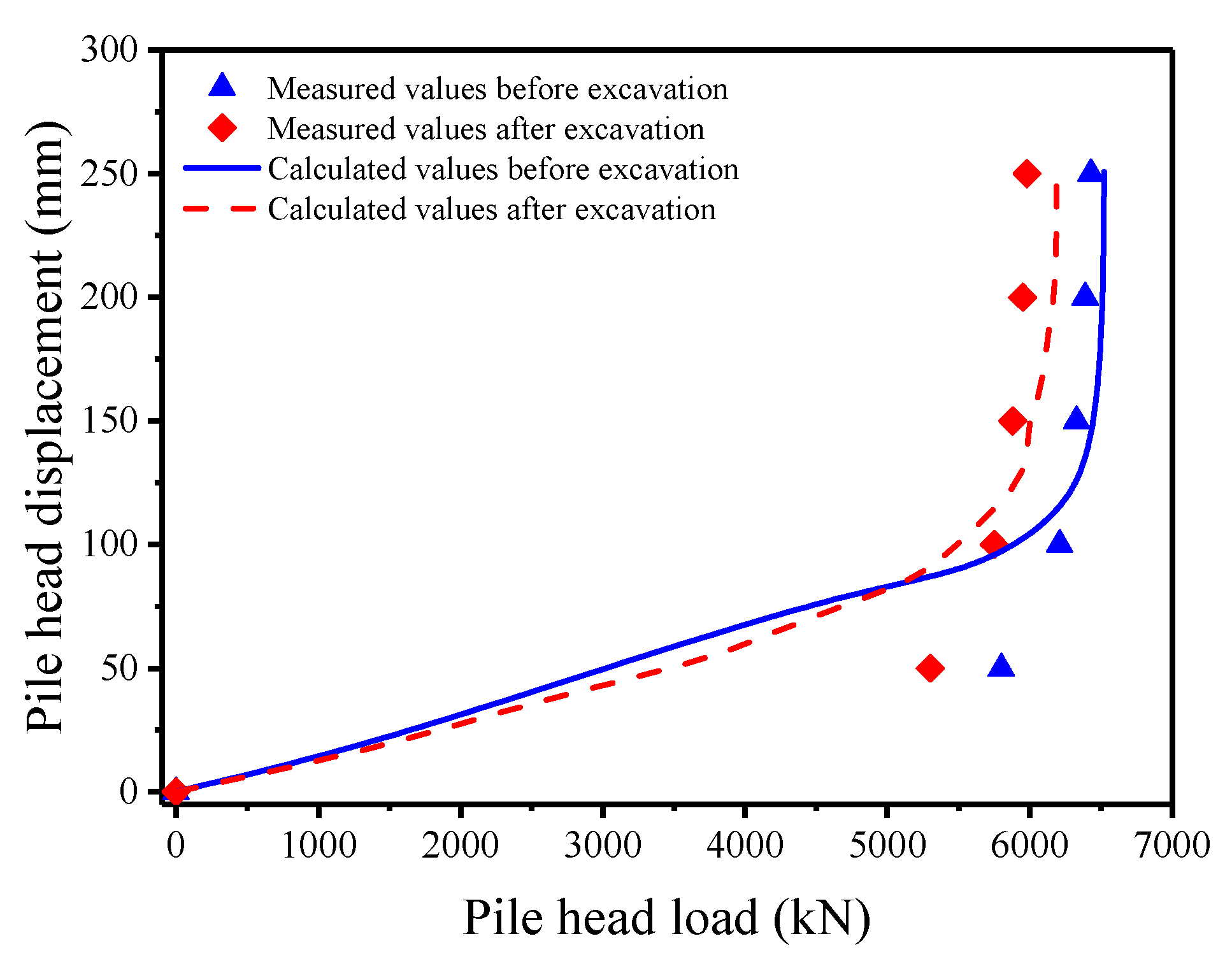
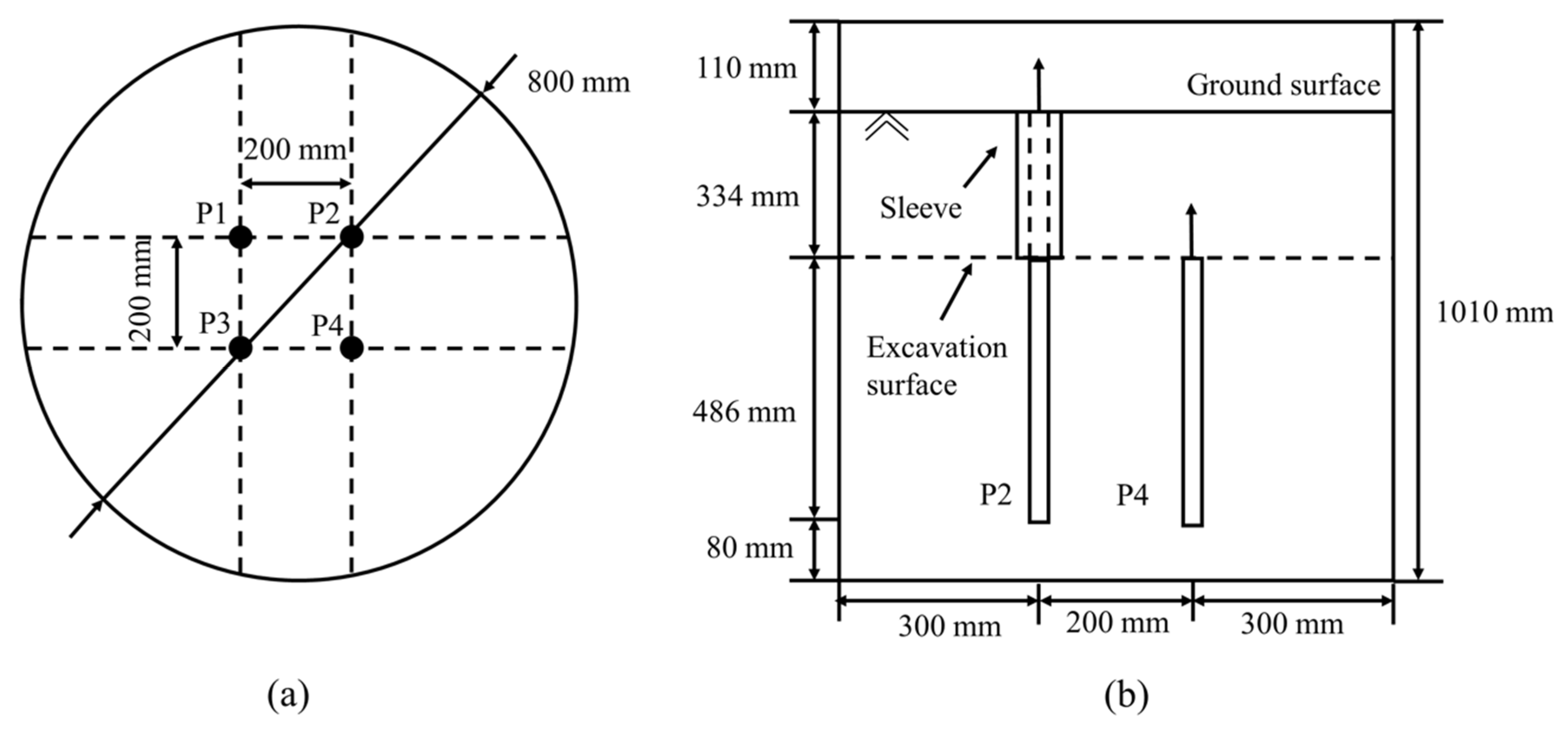


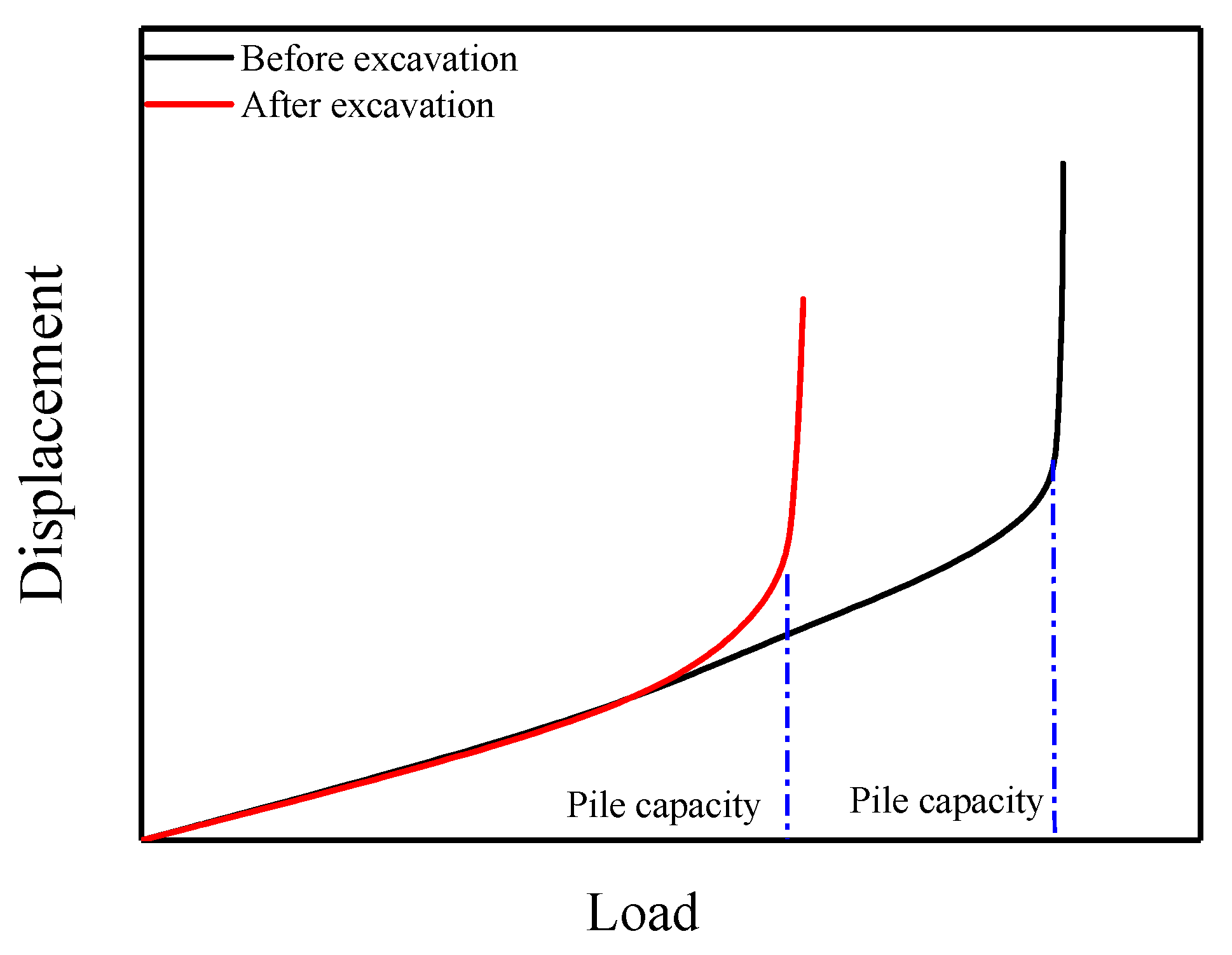
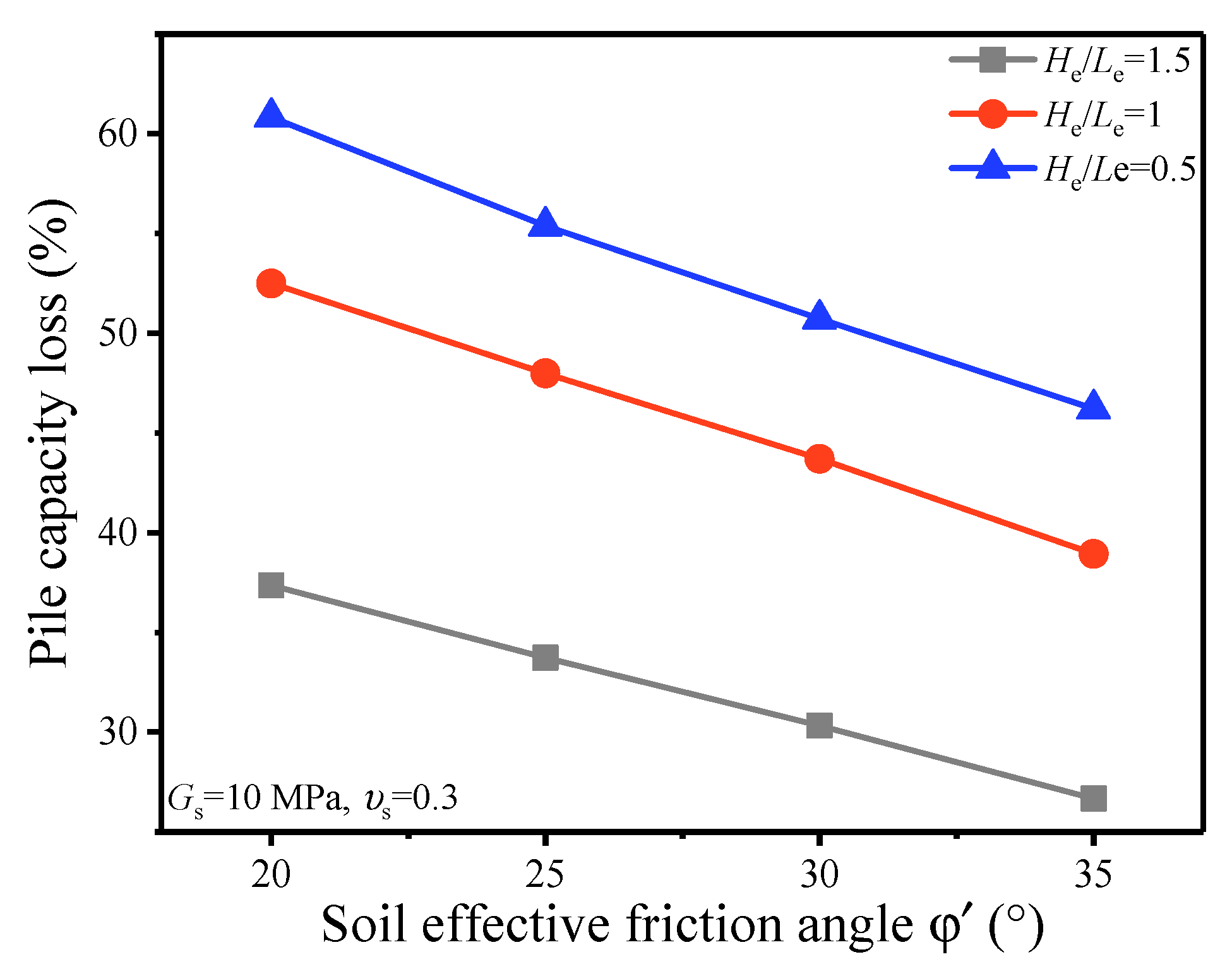
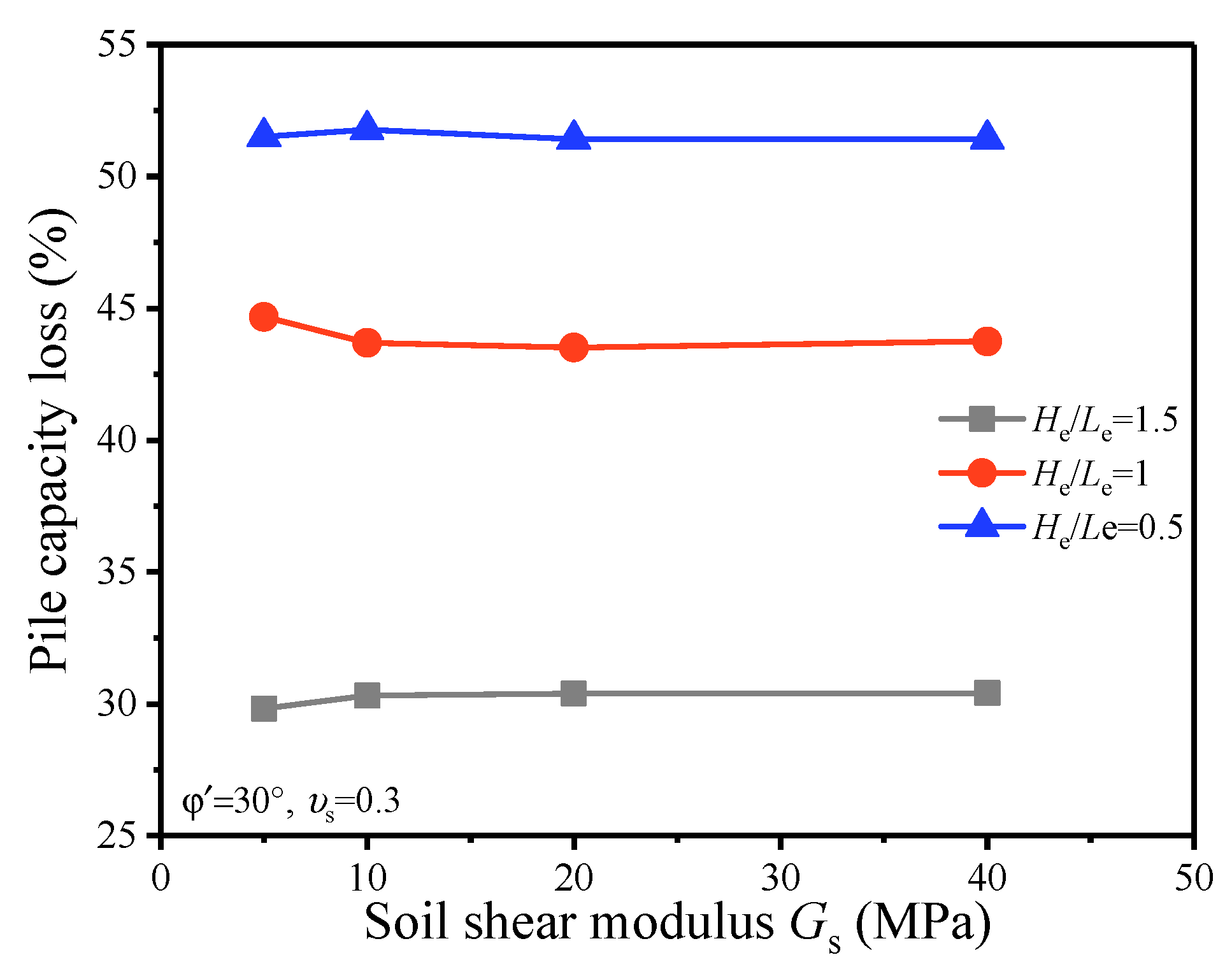

| Suggested Values | Pile-soil Condition | Reference |
|---|---|---|
| Smooth steel pipe piles or concrete piles (Small-displacement piles) | Kulhawy and Many [31] | |
| Smooth steel pipe piles or concrete piles (Large displacement piles) | Kulhawy and Many [31] | |
| Driven or jacked open-ended steel pile piles, normally consolidated soil | Miller and Lutenegger [32] | |
| Driven or jacked open-ended steel pile piles, overconsolidated clay | Miller and Lutenegger [32] | |
| Smooth steel pipe piles or H-piles | Kulhawy and Many [31] | |
| Smooth concrete piles | Kulhawy and Many [31] |
| Water Content (%) | Density (kg·m−3) | Void Ratio | Constrained Modulus (MPa) | Cohesion (kPa) | Effective Friction Angle (°) |
|---|---|---|---|---|---|
| 9.85 | 1540 | 0.95 | 3.92 | 1.08 | 34.0 |
| Pile–Soil Friction Angle (°) | Unit Weight (kN·m−3) | Coefficient of Earth Pressure | Constrained Modulus (MPa) | Cohesion (kPa) | Soil Friction Angle (°) |
|---|---|---|---|---|---|
| 18 | 18.6 | 0.49 | 48 | 1.7 | 30.6 |
| He/Le | ν | Gs (MPa) | φ′ (°) |
|---|---|---|---|
| 0.5, 1, 1.5 | 0.2, 0.3 0.4 0.5 | 5, 10, 20, 40 | 20, 25, 30, 35 |
Publisher’s Note: MDPI stays neutral with regard to jurisdictional claims in published maps and institutional affiliations. |
© 2022 by the authors. Licensee MDPI, Basel, Switzerland. This article is an open access article distributed under the terms and conditions of the Creative Commons Attribution (CC BY) license (https://creativecommons.org/licenses/by/4.0/).
Share and Cite
Li, Z.; Liu, S.; Wu, K.; Lu, T. Analysis on Response of a Single Pile Subjected to Tension Load Considering Excavation Effects. Appl. Sci. 2022, 12, 6717. https://doi.org/10.3390/app12136717
Li Z, Liu S, Wu K, Lu T. Analysis on Response of a Single Pile Subjected to Tension Load Considering Excavation Effects. Applied Sciences. 2022; 12(13):6717. https://doi.org/10.3390/app12136717
Chicago/Turabian StyleLi, Zan, Songyu Liu, Kai Wu, and Taishan Lu. 2022. "Analysis on Response of a Single Pile Subjected to Tension Load Considering Excavation Effects" Applied Sciences 12, no. 13: 6717. https://doi.org/10.3390/app12136717








